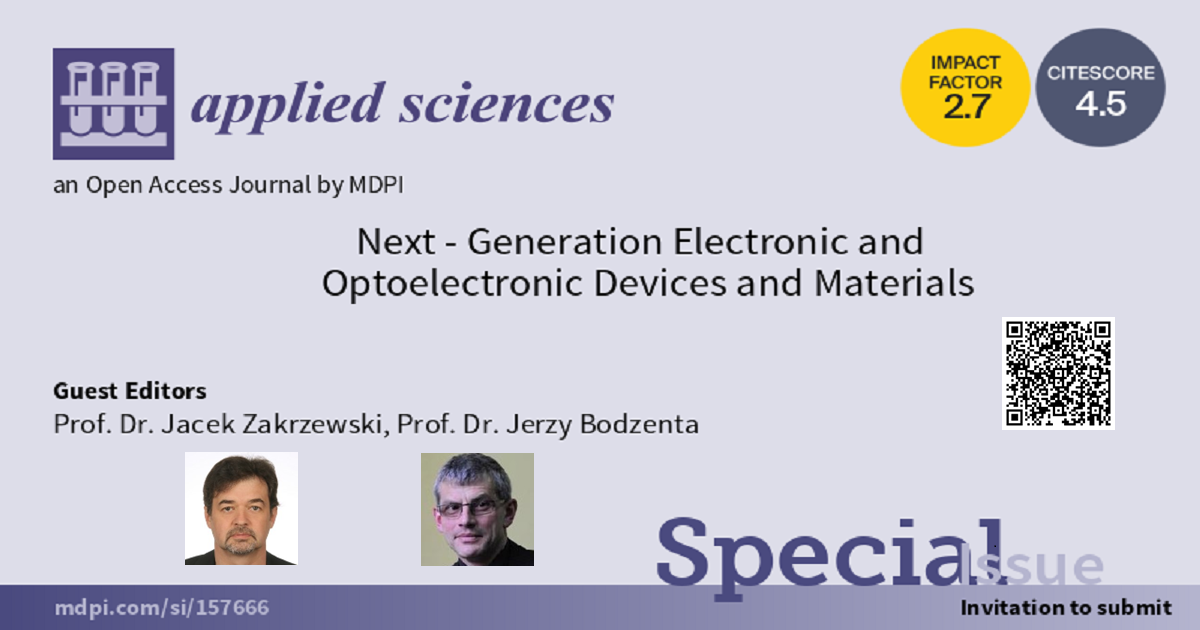Next-Generation Electronic and Optoelectronic Devices and Materials
A special issue of Applied Sciences (ISSN 2076-3417). This special issue belongs to the section "Electrical, Electronics and Communications Engineering".
Deadline for manuscript submissions: closed (30 April 2024) | Viewed by 1151

Special Issue Editors
Interests: semiconductors; optoelectronics; material characterization; materials; microelectronics and semiconductor engineering; materials science; solid-state physics; photothermal measurements
Interests: thermal measurements; heat transport in micro- and nanoscale; scanning probe microscopy; scanning thermal microscopy; photothermal measurements; thermoelectric materials
Special Issue Information
Dear Colleagues,
The development of modern electronic and optoelectronic devices is inextricably linked to the materials used for their production. Existing solutions are constantly being improved, and new challenges are arising. An important topic is the invention of materials that can be mass-produced using inexpensive and energy-efficient production. This Special Issue aims to cover both topics—materials and devices. This Special Issue will focus on the devices' design, architecture, manufacturing, optical, electronic, and thermal properties. It also aims to discuss the current aspects of the theory, design, technology, and characterization of current and new materials. The subjects of interest will be broadband semiconductor materials and structures, thin films, hybrid and dielectric materials, and next-generation materials (such as organic semiconductors, perovskites, and low-dimensional materials).
Prof. Dr. Jacek Zakrzewski
Prof. Dr. Jerzy Bodzenta
Guest Editors
Manuscript Submission Information
Manuscripts should be submitted online at www.mdpi.com by registering and logging in to this website. Once you are registered, click here to go to the submission form. Manuscripts can be submitted until the deadline. All submissions that pass pre-check are peer-reviewed. Accepted papers will be published continuously in the journal (as soon as accepted) and will be listed together on the special issue website. Research articles, review articles as well as short communications are invited. For planned papers, a title and short abstract (about 100 words) can be sent to the Editorial Office for announcement on this website.
Submitted manuscripts should not have been published previously, nor be under consideration for publication elsewhere (except conference proceedings papers). All manuscripts are thoroughly refereed through a single-blind peer-review process. A guide for authors and other relevant information for submission of manuscripts is available on the Instructions for Authors page. Applied Sciences is an international peer-reviewed open access semimonthly journal published by MDPI.
Please visit the Instructions for Authors page before submitting a manuscript. The Article Processing Charge (APC) for publication in this open access journal is 2400 CHF (Swiss Francs). Submitted papers should be well formatted and use good English. Authors may use MDPI's English editing service prior to publication or during author revisions.
Benefits of Publishing in a Special Issue
- Ease of navigation: Grouping papers by topic helps scholars navigate broad scope journals more efficiently.
- Greater discoverability: Special Issues support the reach and impact of scientific research. Articles in Special Issues are more discoverable and cited more frequently.
- Expansion of research network: Special Issues facilitate connections among authors, fostering scientific collaborations.
- External promotion: Articles in Special Issues are often promoted through the journal's social media, increasing their visibility.
- e-Book format: Special Issues with more than 10 articles can be published as dedicated e-books, ensuring wide and rapid dissemination.
Further information on MDPI's Special Issue polices can be found here.






